Chile At The End of the Patria Vieja and Beginning of the Reconquista
The End of the La Plata Viceroyalty Period
Detailed map of Chile and La Plata, on the eve of the two regions' independence from Spain, published forMathew Carey's General Atlas, the first atlas published in America.
The map reflects the sparsely populated interior and complex navigaonal challenges of the coastal regions of the southernmost parts of South America, with only a relatively few settlements and roads shown.
Early 19th Century Chile
The quest for Chilean independence from Spanish colonial dominance commenced notably when Napoleon's imposition of his brother, Joseph Bonaparte, on the Spanish throne destabilized traditional loyalties. The ensuing Chilean War of Independence, part of the larger Spanish American independence movements, saw Chilean society split between independentists, who advocated for separation from Spain, and royalists, who preferred continued allegiance to the Spanish Empire within the framework of the Captaincy General of Chile. This conflict, predominantly an upper-class confrontation, involved large numbers of conscripted mestizos and Native Americans.
The independence movement formally began on September 18, 1810, with the establishment of a national junta in Chile that claimed to rule on behalf of the deposed King Ferdinand VII. The movement's conclusion is variably dated: either 1821, marking the expulsion of Spanish forces from mainland Chile, or 1826, when the last Spanish troops surrendered in Chiloé, integrating the island into the new Chilean republic. The struggle is historically segmented into three phases: the Patria Vieja (1810–1814), the Reconquista (1814–1817), and the Patria Nueva.
The Patria Vieja period was characterized by initial self-governance under José Miguel Carrera, an aristocratic military leader whose authoritarian style provoked widespread resistance. His opposition included Bernardo O'Higgins, who led a faction that eventually engaged in a civil conflict over the direction of the independence movement. This period of governance evolved from an experiment in self-rule to a broader independence campaign.
During the Patria Vieja, ideological divisions emerged between conservatives and liberals within the independence faction, particularly over the extent to which French revolutionary ideals should be adopted. These internal conflicts weakened the movement, allowing Spanish reinforcements from Peru to regain control of Chile by winning the Battle of Rancagua on October 12, 1814. Leaders such as O'Higgins and Carrera were compelled to retreat to Argentina.
The Reconquista, spanning from 1814 to 1817, was marked by Spanish efforts to reinstate strict colonial governance. The severe measures implemented by royalist authorities to suppress dissent drove an increasing number of Chileans towards advocating for unequivocal independence. Manuel Rodríguez emerged as a pivotal figure during this time, symbolizing resistance through his leadership in guerrilla warfare against the Spanish forces.
The independence movement reached a decisive phase when Bernardo O'Higgins allied with José de San Martín of Argentina. Their joint forces crossed the Andes and achieved a significant victory at the Battle of Chacabuco on February 12, 1817, initiating the Patria Nueva. This victory set the stage for further military successes, culminating in San Martín's defeat of the last significant Spanish military presence in Chile at the Battle of Maipú on April 5, 1818. Chile formally declared its independence on February 12, 1818.
Early 19th Century La Plata
In the early 19th century, the Viceroyalty of La Plata faced significant challenges that catalyzed its dissolution and eventual move towards independence. Buenos Aires, as the economic heart of the region, was producing approximately 600,000 head of cattle per year by this period, with a quarter consumed locally. However, economic progress was hampered by British naval blockades that disrupted trade during their wars with Spain.
The financial support for the Viceroyalty primarily came from the silver mines in Upper Peru (modern-day Bolivia), particularly those in Potosí. Initially, these mines contributed about 75% of the region’s revenue but their productivity waned over time, leading to decreased financial support for the administration based in Buenos Aires. Simultaneously, tensions grew in the Alto Plata area (now Paraguay), which chafed under Buenos Aires’ monopolistic control over exports.
Spain, weakened and preoccupied, lost its navy at the Battle of Trafalgar in 1805 and was unable to defend its colonies effectively. This vulnerability led to British invasions of Buenos Aires, first on June 27, 1806, by a force of 1,500 men under Colonel William Carr Beresford. The local population, led by Santiago de Liniers from Montevideo, repelled this initial invasion by December 1806. The British returned with reinforcements, capturing Montevideo in February 1807 under General Sir Samuel Auchmuty. A subsequent larger attack on Buenos Aires led by Lieutenant General John Whitelocke on July 5, 1807, ended disastrously for the British, who lost over half of their force and withdrew after a ceasefire.
These conflicts, along with the lack of support from Spain, fueled local aspirations for independence. By 1814, Buenos Aires had been effectively self-governing for approximately four years, and Paraguay had declared its independence. The viceroyalty effectively ended when rebel forces entered Montevideo in 1814 after a two-year-long siege. Fighting in Upper Peru persisted until 1825, marking the protracted end of Spanish authority in the region.









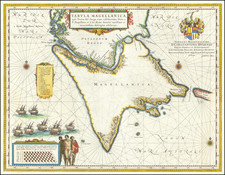
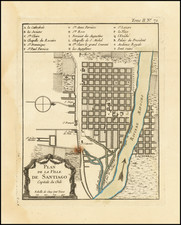
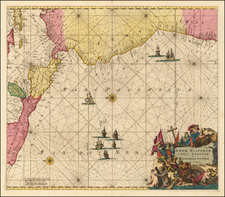
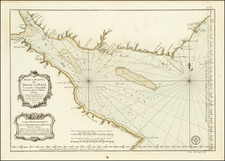
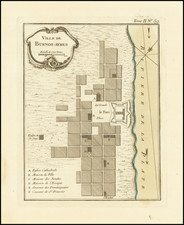
![[Straits of Magellan] Carte Reduite Du Detroit De Magellan Dressee sur les Journaux des Navigateurs; Par le Sr. Bellin . . . 1753](https://storage.googleapis.com/raremaps/img/small/68956.jpg)